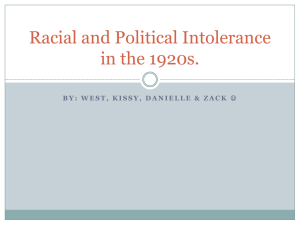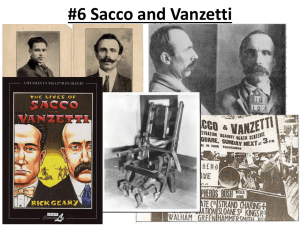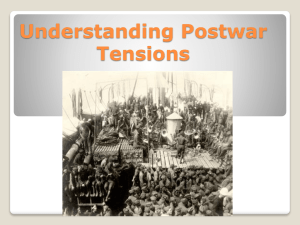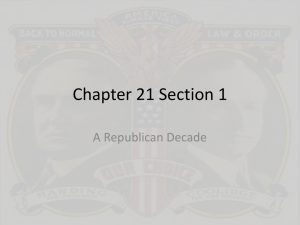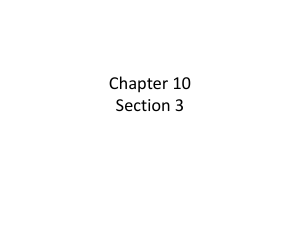Chapter 26 - Understanding Postwar Tensions
advertisement
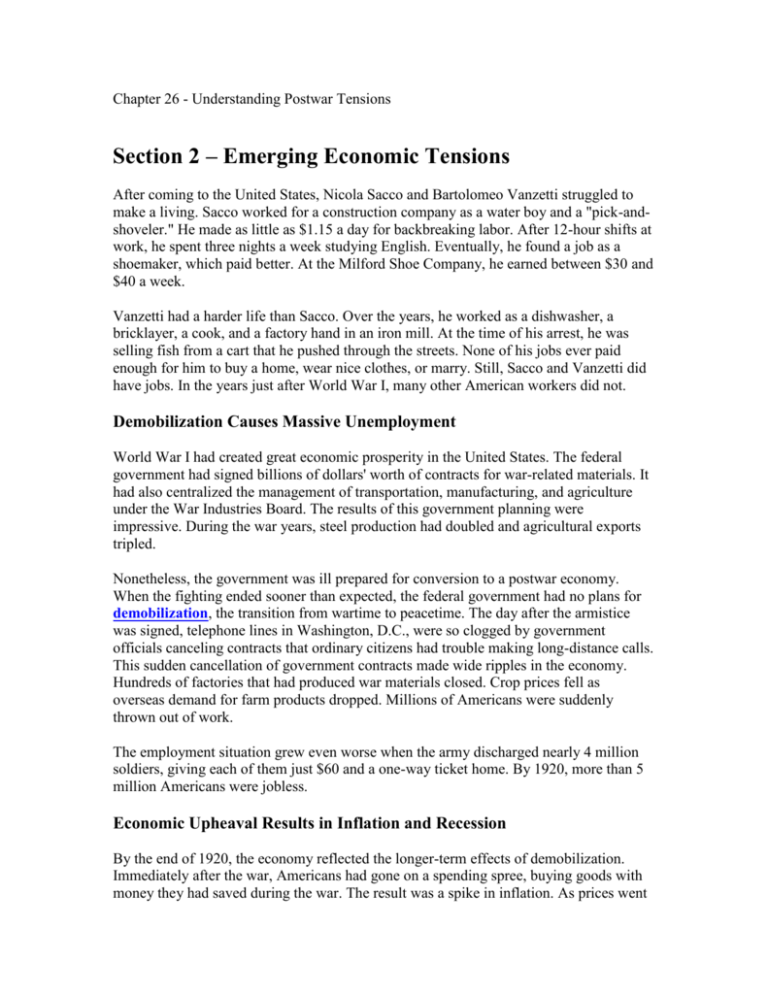
Chapter 26 - Understanding Postwar Tensions Section 2 – Emerging Economic Tensions After coming to the United States, Nicola Sacco and Bartolomeo Vanzetti struggled to make a living. Sacco worked for a construction company as a water boy and a "pick-andshoveler." He made as little as $1.15 a day for backbreaking labor. After 12-hour shifts at work, he spent three nights a week studying English. Eventually, he found a job as a shoemaker, which paid better. At the Milford Shoe Company, he earned between $30 and $40 a week. Vanzetti had a harder life than Sacco. Over the years, he worked as a dishwasher, a bricklayer, a cook, and a factory hand in an iron mill. At the time of his arrest, he was selling fish from a cart that he pushed through the streets. None of his jobs ever paid enough for him to buy a home, wear nice clothes, or marry. Still, Sacco and Vanzetti did have jobs. In the years just after World War I, many other American workers did not. Demobilization Causes Massive Unemployment World War I had created great economic prosperity in the United States. The federal government had signed billions of dollars' worth of contracts for war-related materials. It had also centralized the management of transportation, manufacturing, and agriculture under the War Industries Board. The results of this government planning were impressive. During the war years, steel production had doubled and agricultural exports tripled. Nonetheless, the government was ill prepared for conversion to a postwar economy. When the fighting ended sooner than expected, the federal government had no plans for demobilization, the transition from wartime to peacetime. The day after the armistice was signed, telephone lines in Washington, D.C., were so clogged by government officials canceling contracts that ordinary citizens had trouble making long-distance calls. This sudden cancellation of government contracts made wide ripples in the economy. Hundreds of factories that had produced war materials closed. Crop prices fell as overseas demand for farm products dropped. Millions of Americans were suddenly thrown out of work. The employment situation grew even worse when the army discharged nearly 4 million soldiers, giving each of them just $60 and a one-way ticket home. By 1920, more than 5 million Americans were jobless. Economic Upheaval Results in Inflation and Recession By the end of 1920, the economy reflected the longer-term effects of demobilization. Immediately after the war, Americans had gone on a spending spree, buying goods with money they had saved during the war. The result was a spike in inflation. As prices went up, the value of the dollar shrank by more than 15 percent a year. Average Americans in 1920 paid twice as much for clothing or for foods such as bread, butter, and bacon as they had in 1913. All but the richest Americans saw their standard of living drop as prices rose. The combination of high inflation and rising unemployment led to a sharp recession—a decline in economic activity and prosperity. Between 1920 and 1921, some 100,000 businesses went bankrupt. In those same years, 453,000 farmers lost their land. People got by as best they could, in some cases turning to crime to survive. The robbery-murder involving Sacco and Vanzetti was just one of many violent incidents in a growing crime wave. The robbery took place on April 15, 1920, in South Braintree, Massachusetts. At 3:00 in the afternoon, two payroll masters for the Slater and Morrill shoe factory were carrying lockboxes containing $16,000 from the payroll office to the factory. On the way, they were stopped by two armed bandits. Despite the fact that the two payroll masters dropped their boxes without a struggle, they were shot and left to bleed to death on the street. One of the gunmen fired a shot into the air, signaling their getaway car. From start to finish, the robbery took less than a minute. The South Braintree crime was similar to another robbery four months earlier in nearby Bridgewater, Massachusetts. As historian Frederick Lewis Allen later noted, crimes like this had become so commonplace, they received little newspaper coverage: There had taken place at South Braintree, Massachusetts, a crime so unimportant that it was not even mentioned in the New York Times of the following day—or, for that matter, of the whole following year. It was the sort of crime which was taking place constantly all over the country. —Frederick Lewis Allen, Only Yesterday, 1931 Chapter 26 - Understanding Postwar Tensions Section 3 – Rising Labor Tensions Like many workers after World War I, Sacco and Vanzetti were union men. Sacco and his wife, Rosina, acted in plays to raise money for striking workers. Vanzetti helped organize a strike at the Plymouth Cordage Company, where he worked as a rope maker. He urged immigrant groups to support labor unions. The dedication of the two men to the union movement was one reason working-class communities later raised money for their legal defense. Businesses Return to Prewar Labor Practices After World War I, workers struggled to keep the gains they had made during the war years. As the war had raged, the federal government had encouraged business and labor to cooperate. The National War Labor Board had settled labor disputes on generous terms to keep factories humming. Wages went up as the number of unemployed workers decreased and unions gained more clout. After the war, however, the government stepped aside, and the struggle between business and labor over wages and working conditions resumed. Corporations fought unionization. They reduced wages and paid less attention to employee safety. Some businesses tried to increase the workday to 12 hours, whereas eight hours had been typical during the war. Workers Respond by Organizing and Striking Working-class Americans reacted to deteriorating working conditions in several ways. Many joined unions for the first time. At this time, the American Federation of Labor (AFL) dominated the union movement. The AFL was a group of unions representing skilled workers, such as machinists or mechanics, organized by their craft. The AFL was best known for "bread and butter" unionism. It concentrated on improving wages and working conditions for its union members. In contrast, the more radical Industrial Workers of the World (IWW), whose members were known as Wobblies, saw socialism as the solution to workers' problems. According to the preamble of the IWW constitution, "There can be no peace so long as hunger and want are found among millions of the working people and the few, who make up the employing class, have all the good things of life." The goal of the IWW, proclaimed its leader, Bill Haywood, was to put the working class "in control of the machinery of production and distribution, without regard to the capitalist masters." In 1919, unions staged more than 3,600 strikes across the country, creating the greatest wave of labor unrest in the nation's history. One out of every 10 workers walked off the job at some point during that year. The most dramatic strike took place in Seattle, Washington. When 35,000 shipyard workers were refused a wage increase, the Seattle Central Labor Council called on all city workers to walk off their jobs. Approximately 100,000 people joined Seattle's general strike—a strike by workers in all industries in a region. The strike paralyzed the city. Nearly all economic activity came to a sudden halt. Mayor Ole Hanson condemned the walkout as "an attempted revolution" and called in federal troops to take control of the city. As fears of chaos mounted, Seattle's middle class turned against the workers. After five days, the unions were forced to call off their strike. The most controversial strike of 1919 involved the Boston police force. The police walked off the job after city officials cut their wages and refused to negotiate with their union. At first, Boston's citizens felt sympathy for the police. But that sympathy vanished as the city lapsed into anarchy. Residents set up citizen patrols to fight rising crime. Governor Calvin Coolidge called in National Guard troops to keep order. In his view, "There is no right to strike against the public safety by anybody, anywhere, any time." He fired the striking policemen and hired new ones. His firm stand made Coolidge a national hero. The next year, the Republican Party nominated him as its candidate for vice president. Unions Lose Public Support and Membership As the strikes persisted, middle-class Americans began to view unionism as a threat to their way of life. Strike-related violence added to fears that radical union activity could lead to anarchy. Public hostility was one reason that overall union membership declined in the 1920s. A second was the failure of many strikes to achieve workers' goals. A third reason was the exclusive politics of many unions. The AFL, for example, limited its membership by refusing to organize unskilled employees. It also excluded women, African Americans, and most immigrants. In response, African Americans organized their own unions. The best known, the Brotherhood of Sleeping Car Porters, was a union of black railroad workers led by A. Philip Randolph. In addition, a number of Supreme Court decisions weakened unions. First, the Court restricted unions' right to boycott a business that fought unionization. Then, in 1922, the Court declared unconstitutional a federal child labor law. A year later, the Court rejected a Washington, D.C., law that established a minimum wage for women workers. These decisions hurt labor unions by making it easier for companies to hire children and women at low wages. The diminishing power of unions had a negative effect on workers. Even after the postwar recession ended, many working-class Americans gained little economic ground. Their average income remained well below $1,500 per year at a time when families needed more than that to get by. Chapter 26 - Understanding Postwar Tensions Section 4 – Growing Political Tensions Nicola Sacco became an anarchist while working in a shoe factory. Bartolomeo Vanzetti learned about anarchism while working at a rope factory. The two met in 1917, when they fled to Mexico to escape the military draft. When they returned to Massachusetts, they joined an East Boston anarchists' group. Vanzetti later boasted, "Both Nick and I are anarchists—the radical of the radical." On the night of their arrest, both were carrying guns. Sacco also had a pamphlet advertising an anarchist rally at which Vanzetti would speak. After their trial, many came to believe that Sacco and Vanzetti had been convicted because of their radical politics. A Bomb Scare Fuels Fear of Radical Groups On April 28, 1919, a mysterious package arrived in Seattle mayor Ole Hanson's office. The package contained a bomb. The next day, a similar package sent to former Georgia Senator Thomas Hardwick exploded, injuring his maid. Acting on a tip from a New York City postal worker, the post office found 34 more bombs. The addressees included capitalists like John D. Rockefeller and political figures like Supreme Court Justice Oliver Wendell Holmes. No one ever learned who mailed the bombs. Many Americans saw the bomb scare as another sign that radicalism was threatening public order. Radicalism is a point of view favoring extreme change, especially in social or economic structures. At this time, it referred to the ideas of socialist, communist, and anarchist groups. Socialists called for public ownership of the means of production, including land and factories. They believed such changes could be brought about through peaceful reforms. Communists followed the economic theories of the German philosopher Karl Marx (1818–1883). Similar to socialism, communism called for public ownership of the means of production. The result would be a classless society in which all people shared equally in the wealth produced by their labor. Communists, however, believed such change could only be brought about through a revolution by the working class. American communists drew inspiration from the Russian Revolution of 1917. During that time of unrest, a small group of communists called Bolsheviks, led by Vladimir Lenin, had seized control of the country. The Bolsheviks hoped their success would spark communist revolutions in other countries. When that did not happen, Lenin established the Comintern (Communist International). The Comintern united radical groups throughout the world who accepted Lenin's views on the need for revolution to create a communist state. Anarchists opposed all systems of government. They wanted a society based on freedom, mutual respect, and cooperation. Most anarchists were peaceful, but they had been associated with violence since the Chicago Haymarket Square bombing of 1886. In that incident, seven policemen were killed as they broke up an anarchist rally. None of these radical groups was very large. Combined, their membership came to less than 1 percent of the adult population. Nor were they very effective. They argued constantly among themselves. Still, many Americans viewed them with suspicion and alarm. This postwar fear of radicals became known as the Red Scare. Red was slang for communist. The Red Scare Leads to Raids on "Subversives" On June 2, 1919, the intensity of the Red Scare increased. Eight bombs exploded in eight cities at the same time. One target was Attorney General Mitchell Palmer's house in Washington, D.C. In response, Palmer launched a campaign against subversives, or people who sought to overthrow the government. Palmer and his assistant, J. Edgar Hoover, conducted raids on homes, businesses, and meeting places of people they thought might be subversives. The Palmer Raids sought weapons, explosives, and other evidence of violent activity. Officials entered buildings without warrants and seized records without permission. With little or no cause, they arrested 6,000 suspected radicals. Foreign-born suspects were deported, many without a court hearing. The only evidence of violent activity they found was three pistols. Civil Liberties Suffer Palmer's tactics trampled civil liberties, basic rights guaranteed by law. Newspaper editor Walter Lippmann wrote of the abuses: "It is forever incredible that an administration announcing the most spacious ideals in our history should have done more to endanger fundamental American liberties than any group of men for a hundred years." Yet for some Americans, the fear of radicalism overshadowed concerns about abuses of civil liberties. Some 30 states passed sedition laws, which made stirring up opposition to the government a crime. Books considered subversive were removed from public libraries. A mob broke into the offices of a socialist newspaper in New York City and beat up the staff. Another mob seized a Wobbly out of a jail in Washington, hanged him from a bridge, and used his body for target practice. Palmer had hoped to ride the wave of public alarm about radicals all the way to the White House. But he went too far when he announced that a plot to overthrow the government would begin in New York City on May 1, 1920. As that day drew near, the city's police force was put on 24-hour duty. Politicians were given armed guards for protection. When nothing happened, Palmer's political ambitions were shattered. After this false alarm, the country worried less about subversion. Most of the people arrested in the Palmer Raids were released without being accused of a crime. Still, the campaign had crippled the nation's radical movements. Chapter 26 - Understanding Postwar Tensions Section 5 – Increasing Social Tensions The police investigating the South Braintree robbery had little to go on except eyewitness accounts of two bandits who "looked Italian." Three weeks later, the police arrested Sacco and Vanzetti. When searched, the suspects were found to be carrying pistols and ammunition. When questioned, they lied about where they had been and how they had obtained their guns. Their behavior made them look suspicious to the police and, later, to a jury. But during this troubled time, some native-born Americans eyed many immigrants—especially those who were poor and spoke little English—with suspicion. Increased Immigration Causes a Revival of Nativism Between 1905 and 1914, a million people a year immigrated to the United States. Most came from southern and eastern Europe. Immigration dipped sharply during World War I and then picked up again afterward. In 1920, about 430,000 foreigners entered the country. A year later, that number almost doubled. The rising tide of immigrants triggered a resurgence of nativism along with calls for immigration restriction. Many nativists feared that the latest immigrants would never become "100 percent American." As one nativist warned, "There are vast communities in the nation thinking today not in terms of America, but in terms of Old World prejudices, theories, and animosities." Others argued that reducing immigration would relieve urban crowding and reduce ethnic conflicts. Union members favored restrictions because they worried that immigrants were taking jobs from union workers. Even some large employers supported immigration restriction. For this group, fear of immigrant radicalism had come to outweigh their desire for cheap immigrant labor. New Laws Close the Nation's "Open Door" to Immigrants Congress responded to anti-immigrant pressure by passing the Emergency Immigration Act of 1921. This new law capped the number of people allowed into the country each year at 375,000. It also introduced a quota system to limit the number of immigrants from each country. The quota, or maximum number, was set at 3 percent of a country's residents in the United States in 1910. The quota system was intended to be a temporary measure until Congress could study immigration more closely. Three years later, Congress passed the Immigration Act of 1924. This law reduced the number of immigrants allowed into the country each year to 164,000. It also cut quotas to 2 percent of a country's residents in the United States in 1890. That had been a time when most immigrants came from northern Europe. By moving the date back, the law severely reduced immigration from southern and eastern Europe. The new law also banned all immigration from Asia. When the Japanese government heard this news, it declared a national day of mourning. By the end of the decade, immigration was more than one quarter of what it had been in 1921. But even that was not enough of a reduction for many nativists. In 1929, they persuaded Congress to lower the number of immigrants each year to 150,000. A Revived Ku Klux Klan Targets "Alien" Influences Anti-immigrant feelings played a role in the revival of the Ku Klux Klan. The Klan was reborn in Atlanta, Georgia, in 1915 after the lynching of Leo Frank, a Jewish factory manager. Frank had been condemned to death for killing a young girl named Mary Phagan. Convinced that Frank was innocent, the governor of Georgia reduced Frank's sentence to life imprisonment. At that point, armed men, calling themselves the Knights of Mary Phagan, broke Frank out of jail and hanged him. The Knights then reformed themselves as the new invisible order of the Ku Klux Klan. The revived Ku Klux Klan portrayed itself as a defender of American values. It restricted membership to native-born white Protestants and set itself against African Americans, immigrants, Catholics, and Jews. "The Klan is intolerant," bragged its Imperial Wizard, Hiram Wesley Evans, "of the people who are trying to destroy our traditional Americanism . . . aliens who are constantly trying to change our civilization into something that will suit themselves better." In the early 1920s, the Klan swelled to between 3 and 4 million members and gained considerable political power throughout the country. Lawmakers supported by the Klan won control of state legislatures in Oregon, Oklahoma, Texas, and Indiana. To demonstrate their power, Klan members held massive marches in Washington, D.C., and other major cities. Yet the Klan's violence and intimidation remained secretive. They often struck at night, wearing hoods that concealed their faces and using whippings, kidnappings, cross burnings, arson, and murder to terrorize entire communities. The American Civil Liberties Union Defends Unpopular Views The views of nativists and the Klan did not go unchallenged. In 1920, a group of pacifists and social activists founded the American Civil Liberties Union (ACLU) to protect freedom of speech. The ACLU specialized in the defense of unpopular individuals and groups, including Nicola Sacco and Bartolomeo Vanzetti. In the first year of the ACLU, its lawyers fought to protect immigrants who had been rounded up in the Palmer Raids for their radical beliefs from being deported. The ACLU also defended the right of trade unions to hold meetings and organize workers. ACLU lawyers helped win the release of hundreds of Wobblies and other pacifists who had been jailed during the war for expressing antiwar sentiments. The ACLU opposed censorship by fighting efforts by the Customs Office and the Post Office to ban certain books from the mail. As you will read in Chapter 29, the ACLU would later play a leading role in one of the most controversial trials of the 1920s. [American Civil Liberties Union (ACLU): an organization founded in 1920 to defend Americans' rights and freedoms as given in the Constitution] [quota system: established by the Emergency Immigration Act of 1921, a system limiting immigration to the United States by permitting no more immigrants from a country than 3 percent of the number of that country's residents living in the United States in 1910; the Immigration Act of 1924 reduced the quota to 2 percent of the number of a country's residents living in the United States in 1890] Chapter 26 - Understanding Postwar Tensions Section 6 – Enduring Racial and Religious Tensions On July 27, 1927, six years after Sacco and Vanzetti were convicted of murder, the Lowell Committee concluded that the trial of the two men had been fair. On August 23, 1927, the two men were executed. Decades after their executions, doubts remain about their guilt. Modern analysis of the evidence has confirmed that the gun found on Sacco at the time of his arrest was one of the murder weapons. This suggests that Sacco was guilty of the crime. But no one has found proof to link Vanzetti to the murders. "I have suffered because I was an Italian," Vanzetti wrote from prison. Asians and African Americans Face Discrimination Italians were not the only victims of such prejudice. Asian immigrants also faced severe legal discrimination. Asians were barred from becoming citizens and, in several states, from owning land. Many states also banned marriages between whites and Asians. African Americans faced continuing discrimination as well. At the end of World War I, returning black soldiers had high hopes that their service to the country would lessen prejudice. These hopes proved illusory. Black veterans had problems finding jobs. In some places, lynching made an ugly comeback. More than 70 blacks were murdered by lynch mobs in 1919. In the summer of 1919, tensions between whites and blacks erupted into race riots. The most serious riot occurred in Chicago when whites killed a black swimmer who had strayed into the white section of a Lake Michigan beach. Some 38 people were killed and 500 injured in the riots that followed. The African American poet Claude McKay wrote of the summer of 1919: If we must die, let it not be like hogs Hunted and penned in an inglorious spot, While round us bark the mad and hungry dogs, Making their mock at our accursed lot. If we must die, O let us nobly die, . . . Like men we'll face the murderous, cowardly pack, Pressed to the wall, dying, but fighting back! —Claude McKay, "If We Must Die," 1919 In this climate of violence, many African Americans responded to the message of a leader named Marcus Garvey. The Jamaican-born Garvey believed blacks would never be treated fairly in a white-dominated country. "Our success educationally, industrially, and politically is based upon the protection of a nation founded by ourselves," he argued. "And the nation can be nowhere else but in Africa." Garvey's Back-to-Africa movement attracted up to 2 million followers. He also collected enough money to start several businesses, including a steamship line intended to transport his followers to Africa. In 1925, however, Garvey was imprisoned for mail fraud connected with the sale of stock in one of his businesses. After that, his Back-toAfrica movement faded away. Yet Garvey had raised a critical issue: Should African Americans create a separate society or work for an integrated one? Jews and Catholics Battle Religious Prejudice The influx of 2.4 million Jewish immigrants from eastern Europe stirred up antiSemitism—prejudice against Jews. In some communities, landlords refused to rent apartments to Jewish tenants. Colleges limited the number of Jewish students they accepted. Many ads for jobs stated "Christians only." The Leo Frank case, which gave birth to the new Ku Klux Klan, also led to the founding of the Anti-Defamation League (ADL) in 1913. The organization's immediate goal was "to stop the defamation [false accusation] of the Jewish people." Its longer-term mission was "to secure justice and fair treatment to all citizens alike." Throughout the 1920s, the ADL battled discrimination against Jews in all areas of life. Catholics were also targets of religious prejudice. In 1928, the Democratic Party nominated New York Governor Al Smith, a Catholic, for president. Soon, rumors swept the country that if Smith were elected, the Catholic pope would run the United States. Smith spent most of the campaign trying to persuade voters that his religious beliefs did not present a threat to the nation. Smith was not convincing enough to overcome strong anti-Catholic sentiment in many parts of the country. For the first time since the end of Reconstruction, the Republican Party carried several states in the South. More than 30 years would pass before another Catholic candidate would be nominated for the nation's highest office. Chapter 26 - Understanding Postwar Tensions Summary Rising economic, political, and social tensions marked the years just after World War I. This tense atmosphere affected the murder trial of Nicola Sacco and Bartolomeo Vanzetti. Both men were sentenced to death, despite weak evidence. Some Americans saw Sacco and Vanzetti as victims of prejudice against immigrants and radicals. Recession A poorly planned demobilization resulted in an economic recession after World War I. As unemployment rose, living standards for all but the richest Americans declined. Labor unrest Unions staged thousands of strikes for better wages and working conditions. Despite these efforts, unions began to lose strength, and their membership declined. Red Scare Fear of socialists, communists, and anarchists fueled the Red Scare. Attorney General Mitchell Palmer led raids against suspected subversives, often violating their civil liberties. Immigration restriction Congress responded to anti-immigrant pressure by restricting immigration. A quota system also limited the number of immigrants from each country. Back-to-Africa movement African Americans were disappointed that their service to the country in World War I did not reduce racial prejudice. Marcus Garvey's Back-to-Africa movement appealed to blacks who had given up hope for equality in the United States. Discrimination Nativism surged in the postwar years. A revived Ku Klux Klan targeted blacks, immigrants, Jews, and Catholics as un-American. The Anti-Defamation League began in response to anti-Semitism. The American Civil Liberties Union formed to protect freedom of speech.
